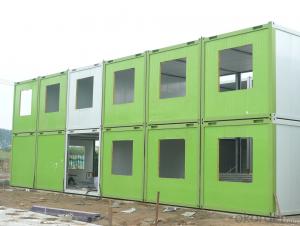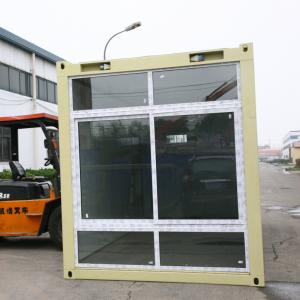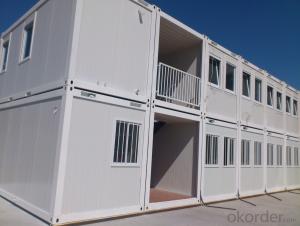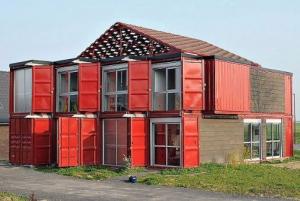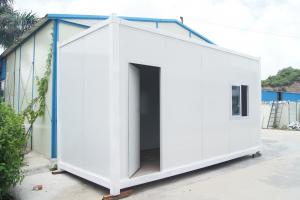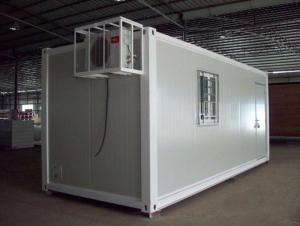Custom Modular Prefab Container House S20-1 in Papua New Guinean With Firm Structure
- Loading Port:
- Tianjin
- Payment Terms:
- TT OR LC
- Min Order Qty:
- -
- Supply Capability:
- 500 Sets set/month
OKorder Service Pledge
OKorder Financial Service
You Might Also Like
20ft flat packed prefab container hotel model
This prefab container hotel model is jointed by our basic product called Flat-packed container house. It is widely used foroffice, accommodation and commercial kiosk.
ProductFeatures:

Dimension(mm)&Weight(kg)
Type | External | Internal | Weight (kg) | |||||
Length | Width | Height (package) | Height (assembled) | Length | Width | Height | ||
20’ | 6055 | 2435 | 648/864 | 2591/2790 | 5860 | 2240 | 2500 | from 1850 |
Floor
Steel frame | - made from cold rolled, welded steel profiles, 4 mm thick |
- 4 corner casts, welded | |
- 2 fork lift pockets (except 30’) - distance 1200mm (internal clearance of fork lift pockets: 240×80 mm) | |
- steel cross members, thickness=2mm | |
Insulation | - 100 mm thick Rock Wool |
Subfloor | - 0.5mm thick, galvanized steel sheet |
Floor | - 18mm plywood board |
- 1.8mm PVC floor - flammability class B1 - hardly combustible - smoke density class Q1 - low smoke emission - wear resistance factor: T level |
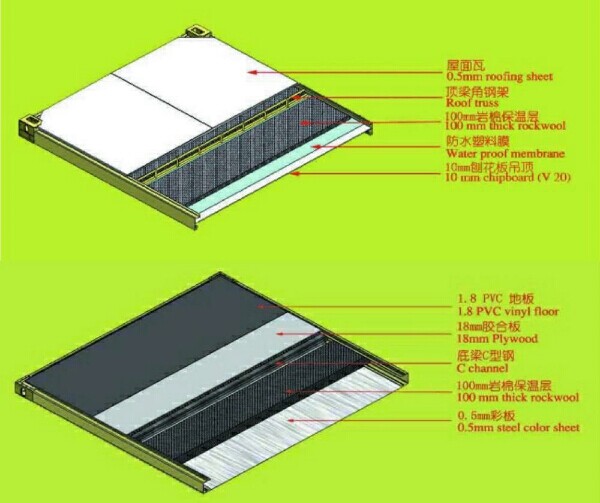
Insulation
Rockwool | - density:120kg/m3 |
- flammability class A- non combustible - smoke density class Q1 - low smoke emissio n | |
- certificated: CE & GL | |
NeoporR | - density:18kg/m3 |
- flammability class B1- non combustible - smoke density class Q1 - low smoke emission | |
- certificated: CE & GL |

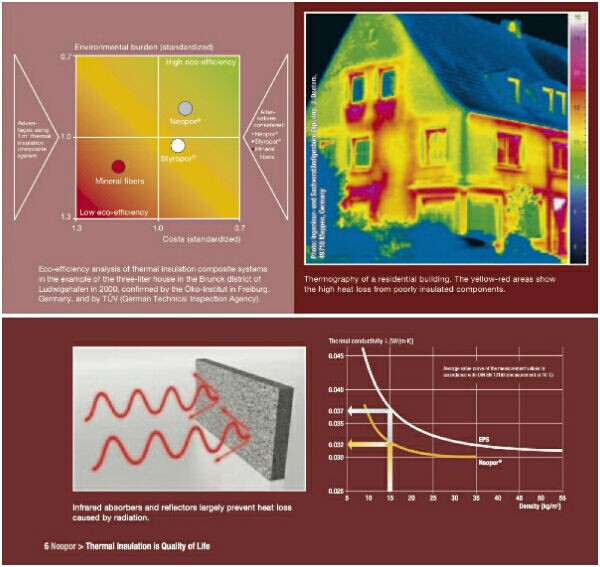
Coatings(Optional)
Deco Coating | Special coating can be applied on top of sandwich wall panel and make the external wall surface looks like plastering finishes or timber finishes. That makes the container house cozy and less industry look. |
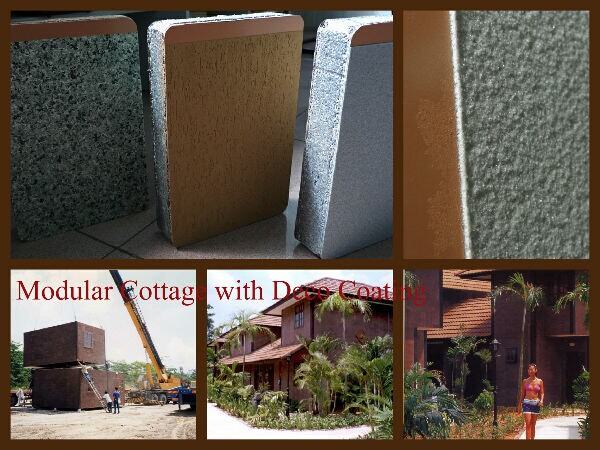
Packaging & Shipping
From ourfactory to overseas client, there are two ways to delivery the houses. If yourport can accept SOC (Shipper’s Owned Container), 4 standard cabins can bepacked as a 20ftcontainer and shipped naked. If can not, 7standard cabins can be loaded into one40ft HC.

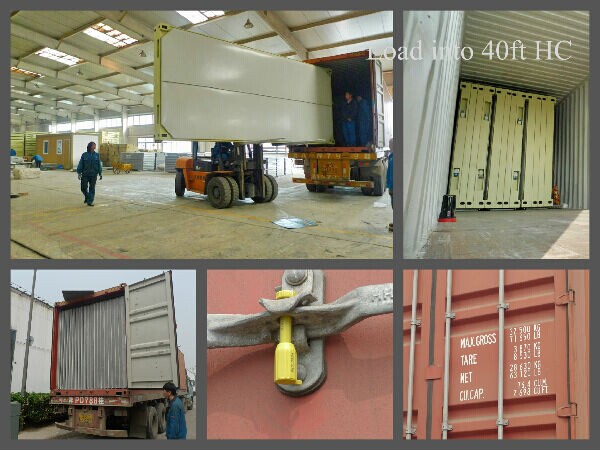
From thedealer’s workshop to the client’s place, it can be delivered by 6m long truck after assembly. The width and height are within traffic limitation.

Our Services
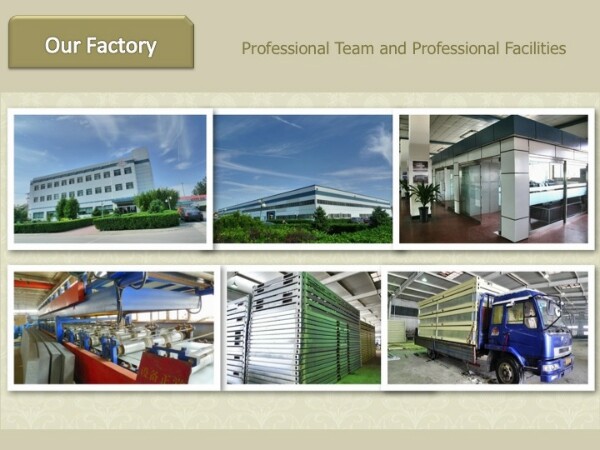
Wecould provide deisgn, manufacture, logistic and on-site instruction services.
Company Information
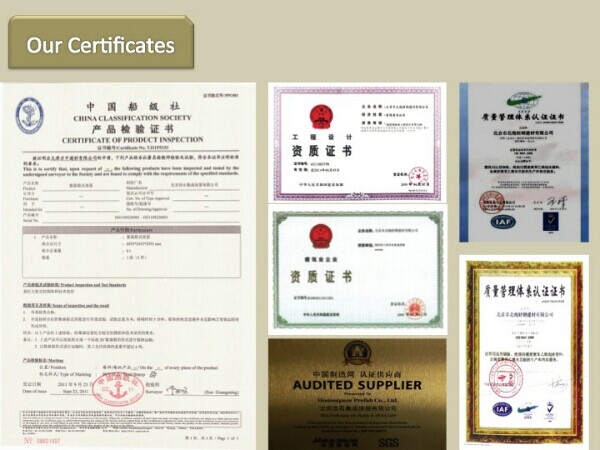


- Q:What are the different design options for container houses?
- Container houses offer a range of design options that allow for customization and versatility in creating one-of-a-kind and functional living spaces. Here are some of the different design possibilities: 1. Utilizing a single container: This straightforward option involves using a single container as the main living area. It can be left as is, with minimal modifications, or converted into a fully functional tiny house with insulation, windows, doors, and necessary amenities. 2. Incorporating multiple containers: This design choice involves combining multiple containers to create a larger living space. Containers can be stacked horizontally or vertically, providing flexible floor plans and multi-level designs. This option offers more square footage and can accommodate larger families or individuals seeking spacious living arrangements. 3. Going off-grid: Container houses can be designed to be completely off-grid, utilizing renewable energy sources like solar panels and rainwater harvesting systems. This design option is perfect for those who want to minimize their environmental impact and live self-sufficiently. 4. Creating hybrid designs: Hybrid container houses blend container modules with traditional construction materials, such as wood or concrete, resulting in a unique and visually appealing design. This option allows for more flexibility in terms of architectural style and can seamlessly integrate with the surrounding environment. 5. Opting for modular designs: Modular container houses are constructed by combining prefabricated container modules, which can be easily transported and assembled on-site. This design option allows for quick construction and easy relocation if needed. 6. Customizing the interior design: Containers can be modified to feature various interior layouts and designs. Whether it's an open-concept living space or partitioned rooms, container houses can be customized to suit specific lifestyle needs and personal preferences. 7. Extending containers: Containers can also be expanded with additional modules or extensions to create larger living spaces. This option is ideal for those who want to start small and gradually expand their container house over time. In summary, the design options for container houses are abundant and can be tailored to meet individual requirements, fostering creativity and innovation in the creation of unique and sustainable living spaces.
- Q:Can container houses be designed for community centers or gathering spaces?
- Yes, container houses can definitely be designed for community centers or gathering spaces. The modular nature of container houses allows for flexible and customizable layouts, making them suitable for various purposes. With proper design and modifications, container houses can be transformed into vibrant and functional spaces that can accommodate community activities, events, and gatherings.
- Q:Can container houses be designed for off-grid living?
- Yes, container houses can definitely be designed for off-grid living. These houses can be customized and equipped with various sustainable and off-grid technologies such as solar panels, rainwater harvesting systems, composting toilets, and efficient insulation to make them self-sufficient and independent from utility services. With careful planning and design, container houses can provide a comfortable and sustainable living environment even in remote or off-grid locations.
- Q:Can container houses be designed to be wheelchair accessible?
- Yes, container houses can be designed to be wheelchair accessible. The design and layout of a container house can be customized to ensure that it meets the needs of wheelchair users. There are several modifications that can be made to achieve wheelchair accessibility in a container house. Firstly, the entry points of the container house can be modified to have ramps or lifts instead of stairs. This allows wheelchair users to easily enter and exit the house without any barriers. The width of the entry points can also be expanded to accommodate wider wheelchairs. Secondly, the interior layout can be designed to have wider doorways and hallways to allow for easy wheelchair maneuverability. The doors can be replaced with wider ones, and the hallways can be widened to meet wheelchair accessibility standards. Additionally, the flooring can be made smooth and even to ensure a comfortable and accessible surface for wheelchair users. Moreover, the bathroom and kitchen areas can be designed with wheelchair accessibility in mind. This includes having lower countertops and sinks, as well as installing grab bars and handrails for added support and stability. Showers can be designed with roll-in access and seating options for wheelchair users. Additionally, the container house can be designed with an open floor plan to provide ample space for wheelchair users to move around freely. The furniture and fixtures can also be chosen or modified to be wheelchair-friendly, with considerations for height and accessibility. In conclusion, container houses can definitely be designed to be wheelchair accessible. With careful planning and customization, it is possible to create a container house that meets the needs of wheelchair users, providing them with a comfortable and accessible living space.
- Q:Can container houses be financed through mortgages?
- Yes, container houses can be financed through mortgages. Many financial institutions and lenders offer mortgage loans specifically for alternative housing options such as container houses. However, the availability and terms of these mortgages may vary depending on the lender and the specific circumstances. It is advisable to consult with different lenders or mortgage brokers to understand the options available and find the best financing solution for container houses. Additionally, factors such as the location of the container house, its size, and the condition of the property may also influence the mortgage approval process.
- Q:Are container houses suitable for outdoor adventure or glamping accommodations?
- Yes, container houses can be suitable for outdoor adventure or glamping accommodations. They are durable, weather-resistant, and can be easily transported to remote locations. Container houses can be customized to provide comfortable and functional living spaces, making them a practical choice for outdoor adventures or glamping experiences.
- Q:Can container houses be designed to have a home library?
- Yes, container houses can definitely be designed to have a home library. With careful planning and creative design, containers can be converted into functional and stylish spaces that accommodate bookshelves, reading nooks, and storage for a vast collection of books. The modular nature of container houses allows for customization, making it possible to incorporate a home library into the overall layout and design of the space.
- Q:Are container houses suitable for remote working spaces?
- Yes, container houses can be suitable for remote working spaces. Container houses offer several advantages that make them well-suited for remote working environments. Firstly, container houses are highly customizable and can be easily transformed into functional and comfortable workspaces. They can be equipped with all the necessary amenities, such as desks, chairs, shelves, and electrical outlets, to create a productive working environment. Additionally, container houses are portable and can be easily transported to remote locations, allowing remote workers to set up their workspace in any desired area. Furthermore, container houses are cost-effective and eco-friendly alternatives to traditional office spaces. They can be constructed using recycled materials and require minimal maintenance and energy consumption. This makes container houses an attractive option for remote workers who want to minimize their environmental impact and reduce costs. Overall, container houses offer the flexibility, functionality, and sustainability that are essential for remote working spaces.
- Q:Are container houses resistant to high temperatures or heatwaves?
- Yes, container houses can be resistant to high temperatures or heatwaves depending on the materials used for insulation and the design features implemented. Proper insulation, ventilation systems, and reflective roof coatings can help regulate the internal temperature and minimize heat transfer, making container houses more resistant to extreme heat conditions.
- Q:Can container houses be designed to have a high ceiling?
- Certainly! Container houses have the potential to feature a lofty ceiling design. Although conventional shipping containers are typically equipped with an 8-foot ceiling, they can be altered and stacked in a manner that creates a roomy and breezy interior with elevated ceilings. Through the elimination of the container's roof and the incorporation of supplementary structural support, it becomes feasible to elevate the ceiling height in accordance with specific design preferences. Moreover, the inclusion of windows or skylights serves to augment the perceived height and welcome natural light, thus imparting a sense of openness and expansiveness to the space. By conducting thorough planning and tailoring the design to individual needs, container houses can indeed boast high ceilings, thereby presenting a contemporary, fashionable, and cozy living environment.
1. Manufacturer Overview |
|
|---|---|
| Location | |
| Year Established | |
| Annual Output Value | |
| Main Markets | |
| Company Certifications | |
2. Manufacturer Certificates |
|
|---|---|
| a) Certification Name | |
| Range | |
| Reference | |
| Validity Period | |
3. Manufacturer Capability |
|
|---|---|
| a)Trade Capacity | |
| Nearest Port | |
| Export Percentage | |
| No.of Employees in Trade Department | |
| Language Spoken: | |
| b)Factory Information | |
| Factory Size: | |
| No. of Production Lines | |
| Contract Manufacturing | |
| Product Price Range | |
Send your message to us
Custom Modular Prefab Container House S20-1 in Papua New Guinean With Firm Structure
- Loading Port:
- Tianjin
- Payment Terms:
- TT OR LC
- Min Order Qty:
- -
- Supply Capability:
- 500 Sets set/month
OKorder Service Pledge
OKorder Financial Service
Similar products
New products
Hot products
Related keywords
